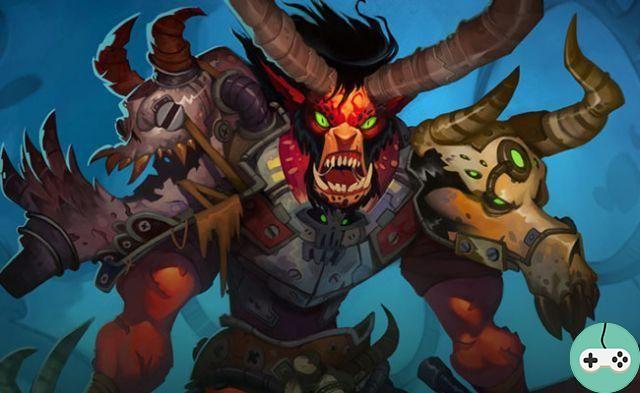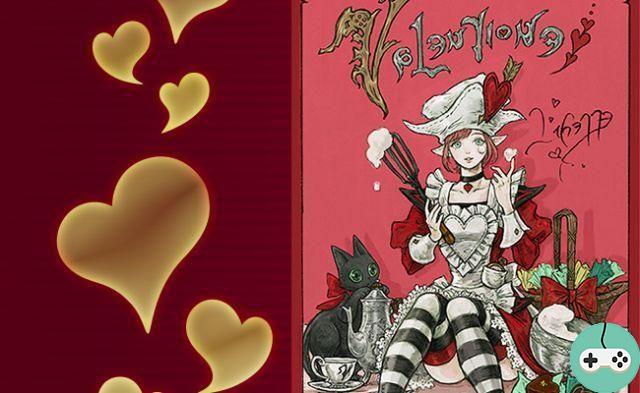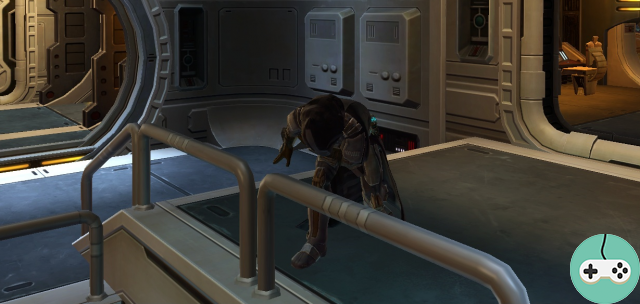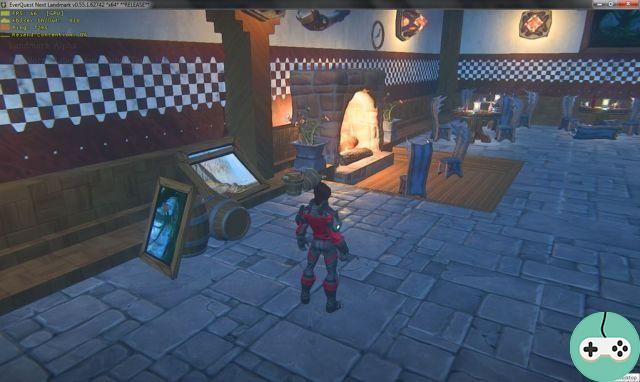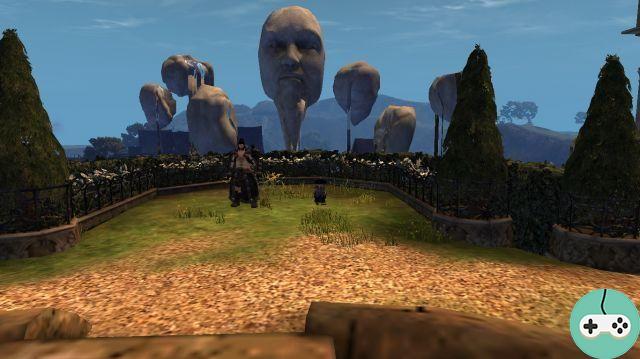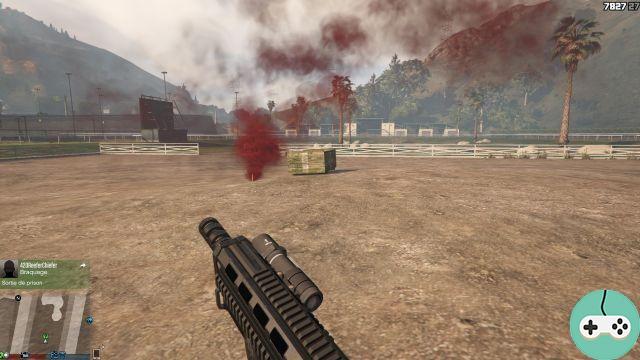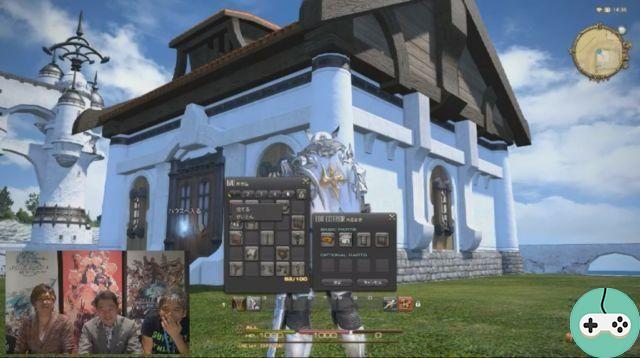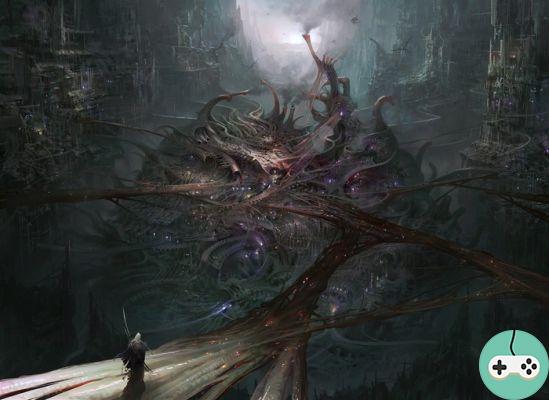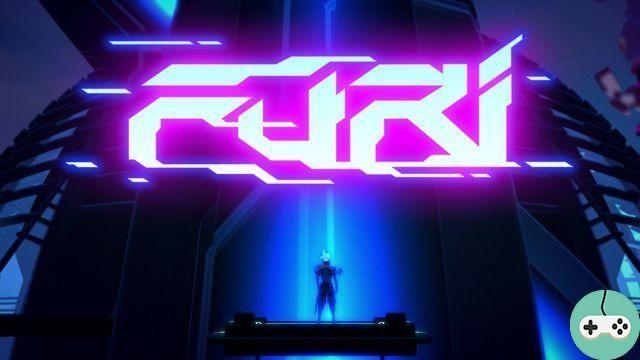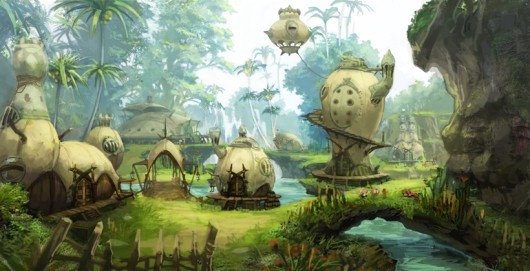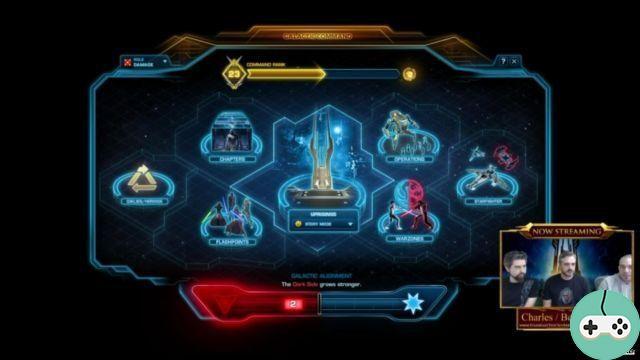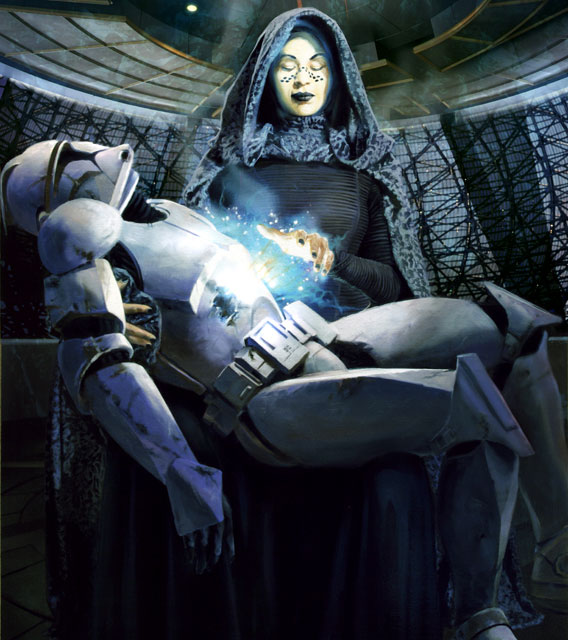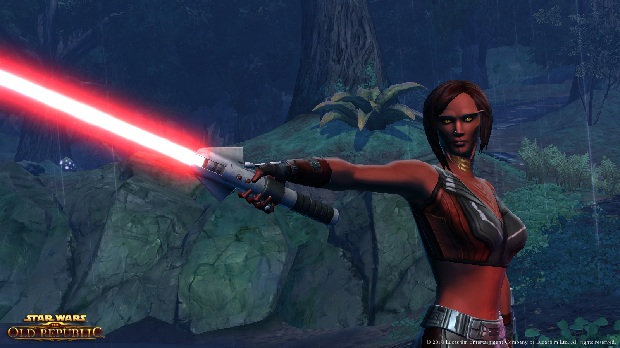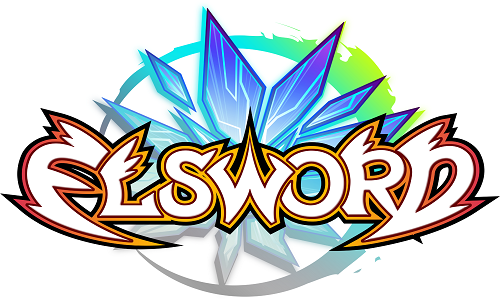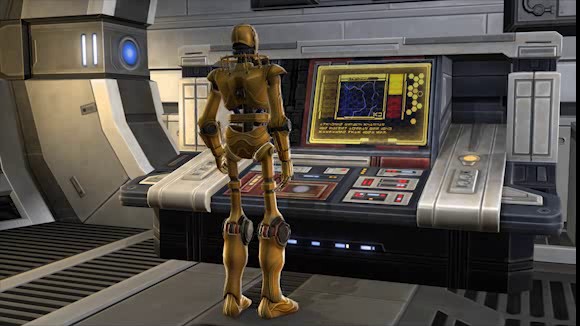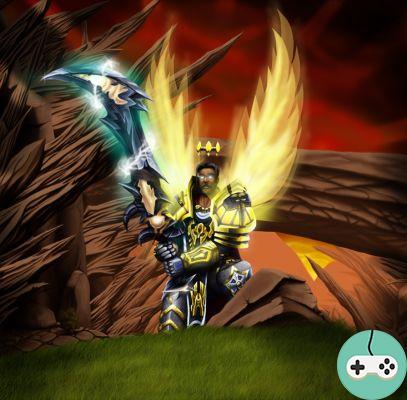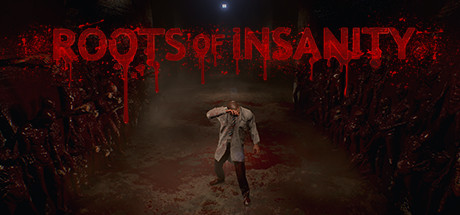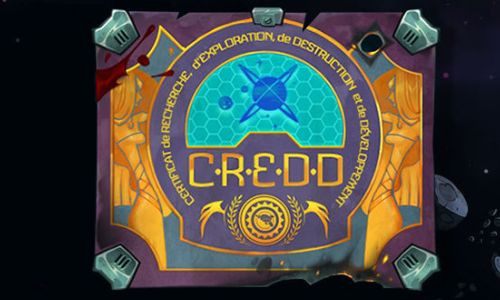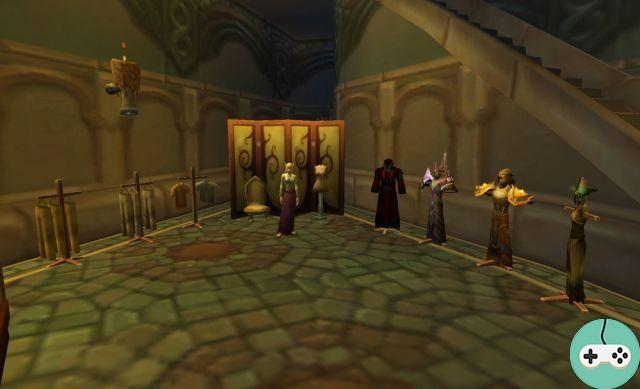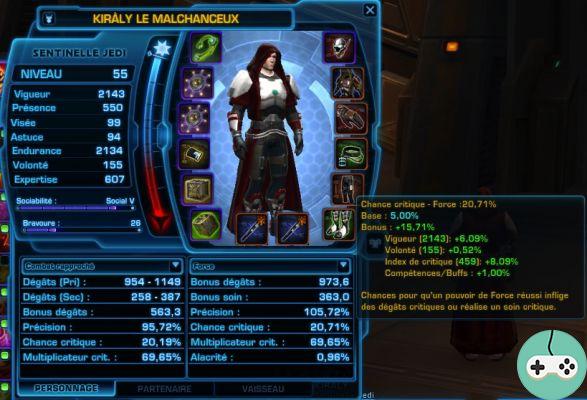
Have you ever heard that such and such a character plays on the C?ritic, such other on the Engime ? That since 2.0, it is more efficient to invest everything in one of the two characteristics in question?

Criticism and power are opposed not only in the debates, but also on the various elements of object modification: they propose either one, or the other, or defense or even absorption (which 'we will leave to the defensive characters). In addition, the critical has a fairly regular damage output, over the length (where others, like the surge, which drops to a certain point), allowing it to compete with the power, which has no output. descending. But in short, is it better to hit a little harder all the time (power), or to hit frankly hard from time to time (critical)?
The first question to ask yourself is whether you need one more than the other. In the majority of cases, it's whether doing critical hits has a side effect. I'm not counting the 15% / 30% / 50% extra damage / healing on critical hits (which is actually an influx bonus on specialization master attacks, usually) because that doesn't matter. influence on the way of playing: it is only a gain of damage, whereas the effects that I designate here increase the resource, reduce its damage, trigger an effect, etc ... In short, modify the gameplay.
If indeed Crit is an integral part of your heal / damage cycles, it makes sense that Crit is more important than Potency. So the question becomes: Are you one of the characters in need of criticism?
Well, ignoring the influx bonuses to master attacks, here are the talents of all classes that make the critical useful:
- Soldiers and Bounty Hunters
- Smugglers and Agents

 First contact (Commando: war medicine) / Critical reaction (Mercenary: close protection) : Critical hits from damage and healing powers have a 50% / 100% chance to grant 3% alacrity for 6 seconds.
First contact (Commando: war medicine) / Critical reaction (Mercenary: close protection) : Critical hits from damage and healing powers have a 50% / 100% chance to grant 3% alacrity for 6 seconds.

 Fighting spirit (Maverick / Thief: perfidy) / Fatal objective (Sniper / Secret agent: fatality) : Critical hits from bleeding / poison effects restore 1 point / 2 points of energy.
Fighting spirit (Maverick / Thief: perfidy) / Fatal objective (Sniper / Secret agent: fatality) : Critical hits from bleeding / poison effects restore 1 point / 2 points of energy.

 Clinical studies (Malfrat: surgery) / Patient examination (Secret agent: medicine) : Diagnosis critical hits restore 15 points / 30 points of energy.
Clinical studies (Malfrat: surgery) / Patient examination (Secret agent: medicine) : Diagnosis critical hits restore 15 points / 30 points of energy.
- Knights and Warriors
- Consular and Inquisitors

 Searing Concentration (Sentinel: surveillance) / Bloodlust (Marauder: annihilation) Direct attacks that critically strike targets with burns / bleeds have a 50% / 100% chance to generate a point of focus / rage.
Searing Concentration (Sentinel: surveillance) / Bloodlust (Marauder: annihilation) Direct attacks that critically strike targets with burns / bleeds have a 50% / 100% chance to generate a point of focus / rage.

 Merciless Zeal (Sentinel: surveillance) / Hunger (Marauder: annihilation) : Critical hits from Burning / Bleeding effects restore 0,5% / 1% of your maximum health.
Merciless Zeal (Sentinel: surveillance) / Hunger (Marauder: annihilation) : Critical hits from Burning / Bleeding effects restore 0,5% / 1% of your maximum health.

 Telekinetic Effusion (Scholar: Telekinesis) / Lightning Effusion (Sorcerer: Lightning) : Critical hits from your Force attacks have a 50% / 100% chance to reduce the Force cost of your next two Force attacks by 75%.
Telekinetic Effusion (Scholar: Telekinesis) / Lightning Effusion (Sorcerer: Lightning) : Critical hits from your Force attacks have a 50% / 100% chance to reduce the Force cost of your next two Force attacks by 75%.

 Psychic Projection (Scholar: Telekinesis) / Lightning Barrage (Wizard: Lightning) : Critical hits from Debilitated Spirit / Ailment have a 50% / 100% chance to double the cycle speed of the next Force Telekinetic / Lightning Bolt.
Psychic Projection (Scholar: Telekinesis) / Lightning Barrage (Wizard: Lightning) : Critical hits from Debilitated Spirit / Ailment have a 50% / 100% chance to double the cycle speed of the next Force Telekinetic / Lightning Bolt.

 Resplendent (Scholar: protection) / Surge of Force (Sorcerer: corruption) : Critical hits from the Heal / Innervation Trance have a 50% / 100% chance to grant a point of Resplendent / Force Surge * (maximum 3).
Resplendent (Scholar: protection) / Surge of Force (Sorcerer: corruption) : Critical hits from the Heal / Innervation Trance have a 50% / 100% chance to grant a point of Resplendent / Force Surge * (maximum 3).
* Resplendent / Force Surge then increases the power of Noble Sacrifice / Consumption or Salvation / Revivification:
- Noble Sacrifice / Consumption does not reduce Force generation (for one point of Resplendent / Surge).
- Hi / Revivify activates 33% faster, per charge (consumes them all).

 Concentrated Insight (Scholar / Shadow: Balance) / Parasit (Sorcerer / Assassin: Madness) : Critical hits for your regular damage restore 0,5% / 1% of your maximum health.
Concentrated Insight (Scholar / Shadow: Balance) / Parasit (Sorcerer / Assassin: Madness) : Critical hits for your regular damage restore 0,5% / 1% of your maximum health.
 Kinetic Field (Shadow: Infiltration) / Entropy Field (Assassin: Deception) : Critical hits have a 50% / 100% chance to grant Kinetic / Entropy Field, reducing damage taken by 1% for 15 seconds, stacking 3 times.
Kinetic Field (Shadow: Infiltration) / Entropy Field (Assassin: Deception) : Critical hits have a 50% / 100% chance to grant Kinetic / Entropy Field, reducing damage taken by 1% for 15 seconds, stacking 3 times.
 Force Synergy (Shadow: Balance) / Exploiting Strikes (Assassin: Madness) : Critical hits from your Force attacks increase the critical strike chance of your melee attacks by 3% / 6% / 9% for 10 seconds.
Force Synergy (Shadow: Balance) / Exploiting Strikes (Assassin: Madness) : Critical hits from your Force attacks increase the critical strike chance of your melee attacks by 3% / 6% / 9% for 10 seconds.
These talents condition the critical need for the character's gameplay. Note that the Consular / Inquisitor clearly seems to be a critical class (for almost all specializations / advanced classes, defensive specialization obviously not included), as well as Sentinels and Marauders in Juyo posture, Thugs and Secret agents who heal, or those who exploit the tree in common (Perfidy / Fatality). Concerning the Commandos / Mercenaries, the talents concerned can be taken by all the specializations (even if, inevitably, one of them is more likely to make you use it). It's up to you to see if you play with it!
Suddenly, for all the other specializations, or hybridizations, we can finally ask the question: from when the power becomes more interesting than the critic, or vice versa?
The first thing I want to do consider, about needing to increase critical or potency in damage, is that it only works on an average. Obviously, a Thug who came out of stealth, and who, luck after lucky, chained you 4-5 critical attacks, which knock you down in ten seconds ... well yes, the critic will have made it easier for him, where the power would not necessarily have allowed him a victory. But the question comes in the long term: if the critical helps once, he may not help another time (same situation: the player casts his big spells, but no crit, the target still stands, and ends his attacker who no longer has any punch). Suddenly, for this specific case, it would be necessary to make an average of all the fights of the thug.
To calculate the increase in damage via an increase in Criticality, it is necessary to have an average damage base. To calculate an average damage via the critical, I do it this way:
Medium Damage * (1- Crit Chance + Crit Chance * Crit Multiplier)
So, for someone with 20% Crit, 55% Surge, and 1500 Base Damage, that works out:
1500 * (1 - 0,2 + 0,2 * 1,55)
And I hope you noticed it: it must be partly wrong. Why ? For two points:
1) Because you use (except maybe scholars and wizards *) attacks that use two types of damage (melee / Strength, distance / tech); so some of your attacks (Strength for Knights / Warriors, Tech for Soldiers / Bounty Hunters, Ranged for Smugglers and Imperial Agents, and Melee for Shadows / Assassins) will more often critical hits, because they benefit from the critical bonus of two primary stats.
* Scholars and Wizards theoretically never use their only two melee attacks.
2) Apart from a few special cases, influx bonuses from your talent trees rarely work for all of your attacks: it is often for your master attacks of your cycles, yes. But you do more. Some specializations are exceptions to this last point, however:
- Healers: This is always a critical bonus on healing. So, all your heals, period (with a caveat for Scholars / Wizards who do not have an influx bonus in their heal tree). Suddenly, all their "attacks" are at the same level.
- Smugglers in the Treachery tree, and Agents in the Doom tree: there too, no influx bonus in the tree.
- The Knights in the Concentration tree and the Warriors in the Rage tree: the 15% critical damage bonus applies to all attacks ... lucky ones ^^
- Guardians and Ravagers: either the bonus (see previous), or no bonus
- Tanks: all classes combined, because none have bonuses. And that's good, they wouldn't have much to do with it ...
- And to make everyone sweat, Shadows / Assassins in Shadow Technique / Surge Charge or Force Technique / Lightning Charge have a 50% bonus on some attacks, 30% on others, and 0% on the rest
However, as you will have understood, this already gives a fairly clear picture of the problem. And so, depending on your character, the Crit / Power ratio may change systematically.
So now, I'll let you open the Excel file where all my tables are listed, to show you the complexity of the debate.
If the power has a simple and regular effect, the critic is influenced by a lot of details: the level. But generally, you optimize yourself at this point when you are level 55. But if you make an exception, remember that it will increase your secondary statistics.
- the type of attack: well yes, a Force attack of a Knight or a Warrior will make more often critical hits than with a Scholar (before any external bonus), because these former have two primary statistics which increase this rate. And each class has its variant.
- the initial damage: as the Crit allows a multiplication of damage, the higher it is, the more the critical hit bonus will be substantial.
- the multiplier (Surge): Obviously, a critical hit that increases damage by 5% will not influence as much as a critical hit that increases damage by 100%. And that's why I drew curves for the master attacks, the latter having an Surge bonus, to put it simply.
- the base critic: to my surprise, I noticed that the critic curves were sometimes seen to be modified when there was a base criticism bonus.
Sheet 3 of the Excel table thus plots the average damage, according to the investment in critical or in power. I have multiplied the curves to show you the differences based on your influx bonus.
- 50%: it's when you have nothing, at all. Neither in the tree, nor in invested influx.
- 70%: I considered that we increased the inflow to 20%, which is a good milestone to reach, in terms of ratio (cheap, and efficient *), something that can be done for almost any class / specialization.
- 85%: with the influx bonus (20%) and a tree bonus of 15%.
- 100%: the influx bonus (20%) and a tree bonus of 30% (the most common).
- 120%: the influx bonus (20%) and a 50% tree bonus (for some lucky guys). And this, every time for the critic and the power.
* 20% influx is achieved with an index of 393, which is objectively quite low (it's 640 to increase to 25%!) Compared to other statistics. If, indeed, I will resume the debates on the inflow in a future part, I can understand that some believe that a slightly higher inflow is needed for the curves. You can modify them by entering another value in the boxes below "MCT" except the first (ie F48, H48, J48 and L48). Be careful, it's a multiplication factor, not a percentage (so it's 1 for + 0% (100%); 1,5 for + 50% (150%), 1,72 for + 72% (172 %), etc.).
On the few numbers just below the graph, I've made it so that you can change them to suit you.
- Increase potency bonus to 0,17 if you consider it to be healing
- Change the level if you don't want to do it for a level 55.
- The critical base will vary the deal: if it is 5% base, it may be that tree talents (from 1 to 3%, or even other if you have other mechanics), a class bonus (5%), and / or a partner inheritance (1%) all increase. And it is also the best place to add the bonus conferred by your primary statistics *.
- The average damage base is 1500, but vary it to 2000, 2500, 3000, or others if you want (knowing that this base must be considered before the critical or power bonus).
- Finally, if you have the knights / warriors bonus, the investment in power will be increased (hence put 1,05 if this is the case).
* this is where sheet 2 of the table serves you: see how much vigor / cleverness / aim / will you have, and you will know how much criticism you get. At level 55, you easily turn between 10% and 16%, including the base 5%.
As the damage can increase, and / or you want to see better where the curves intersect, do not hesitate to vary the scale of the y-axis *.
* Can't figure out how to do it? Right click on the vertical axis, on the right, then “axis format…”. In the "scale" part modify the values of the maximum and the minimum (initially to 5000 and 1500, respectively).
The graph thus obtained will give you a first index of the threshold to reach where the critical becomes more interesting than the power (or vice versa), depending on your attacks. I can advise more particularly Shadows and Assassins who have specialized in their stealth to lean on these curves, because they have two different bonuses to the influx on their master attacks. However, these specializations heavily exploit critical, and increasing it as a priority to potency clearly increases average damage - something I may have experienced with Winto, whom I thank in passing - as the curves seemed to tell him to increase. more power.

If the third sheet is mainly used to give you a general idea, I created the 4th sheet to calculate more precisely your types of damage. Here is how to use this 4th page: The numbers in green are to be filled in / modified, according to your values. They will directly influence the calculations and the graph next to it. The red numbers were not taken into account for the calculation. However, filling in / modifying them allows you to have a better overview. And those in blue are there to help you in the calculations: replace the index, and you will have their values (to then complete the table). The other figures in black come directly from the formulas. Do not modify them especially by deleting the initial content *.
* At worst, download the file again, and / or ask me what you deleted.
How to fill in each box:
- Level. Bah, there, nothing rocket science, it's your level
- The two decimals next to "damage" are their modifiers. If you want to calculate for healing, replace the first one with 0,17 and the second one with 0,14.
- The Primary 1 and Primary 2 stats are directly dependent on your character: Primary 1 is your primary stat * (normally ramped up to huge values), and Primary 2 is the one that affects the 2nd type of damage you deal * (always on depending on your class).
* Knight / Warrior -> Stamina; Smuggler / Agent -> Tip; Consular / Inquisitor -> Will; Soldier / Bounty Hunter -> Aim
* Knight / warrior -> Willpower; Smuggler / Agent -> Aim; Consular / Inquisitor -> Vigor; Soldier / Bounty Hunter -> Tip
- In the investment column, indicate the value you have (including the 5% bonus from the Consular / Inquisitor spell, as well as any bonus via your talent tree), and damage bonuses.
- For the Influx, indicate the ratio to the right of the table (you have a system just above to find the index / ratio ratio). -> In the Legacy section, indicate the various bonuses you have obtained:
- Leave 1 if you have the 1% surge bonus (end of conversation with a melee damage partner), otherwise, put 0.
- Leave 1 if you have the 1% critical bonus (end of conversation with a ranged damage partner), otherwise, put 0.
- Put 1,05 if you have the Consular or Inquisitor class bonus (to get it with other classes, you must finish chapter 2 with a Consular / Inquisitor). Otherwise, let 1 (and not 0!)
- Same with the Jedi Knights / Sith Warriors bonus (5% more damage): 1,05 if you have it, otherwise, 1.
- If you have the 5% crit bonus via one of your Smuggler / Imperial Agent characters, there is a row to modify (0, or 5 if you have it).
In the Tree part, you must put the various obtained via your talent trees:
- You often have a 15% / 30% / 50% bonus on some of your critical attacks (which I call "master attacks" because the most used in your damage cycles). It is this bonus that must be indicated in the influx line. If you don't have one, put 0.
- Quite a few trees have a critical bonus. The second line is there for it, if you have invested in similar talent. Be careful, it affects all your types of damage (so will cloud the results if you only have a bonus on certain attacks).
- Likewise, almost all classes offer a bonus to their main stat in their tree. The Primary line is there for this bonus (1 if there is nothing; 1,06 if 6% more, 1,09 if you have 9%, etc.), but it is just indicative.
For basic damage, I see two ways to do this.
1) You calculate on the average of your base damage. This primarily means bonus to potency and your primary stat. (A simple subtraction according to your indexes will allow you to find them) Thus, you make an average of all this (do not hesitate to count according to the frequency of the attacks), and indicate it in the box. The curves in the graph will give you indexes for an average of your damage.
2) you want to know not globally, but for each attack. For now, put the base damage (without power / primary) of the attack in question, as well as all the bonuses that apply to it (critical / influx, etc.) and you will have the exact results, for the affected attack. And by multiplying the operation, you will find what critical and power rating you need for each of them. And suddenly, you will have to adapt your equipment according to the use of your shots.
I know it takes work for you, but it is not possible to output an Excel table that takes everything into account, while still working for all classes. On the other hand, once cycles / mechanics are established, it might become possible to make one for each specialization *. In the meantime, the second option allows you to give you enough information to guide you.
* For those who are hoping that I will put together an article for each situation concerned… I'm sorry, but I don't have enough characters for that!
You can then read the graph on the right: the 4 double curves allow you to compare the critical and the power in the following four cases:
- Normal attacks using only your primary primary stat.
- Normal attacks using your primary primary stat and a secondary one.
- Master attacks (tree surge bonus) using only your primary primary stat.
- Master attacks (influx bonus in the tree) using your primary primary statistic and a secondary one.
Depending on the attacks involved, some curves will probably be ignored (eg Sentinel / Marauder Juyo → master attacks are only burns / bleeds, which are Force attacks (1st and 2nd primary stats)). Normally you will have a curve that is rounded, tapered off, and eventually crossed to the right at some point.
If the crossing seems to indicate the limit amount to invest in criticism, beyond which the power becomes more profitable than the critic, I think that there is however a margin of maneuver: when the curve increases less "steeply" than the line (but is above), investing in crit starts to be weaker than in power.
If you did not understand what I just said: look at how many indexes the power and the critic cross (for example 1420). Divide by 2, and look where it ends on the curve (so at 710): normally, you are about in the middle of the arc above the right of the power, and it "goes down" afterwards. If it goes down again, it's less good than potency (so, in our example, the character should increase his critical to 710). It is possible that the right of power is always greater (in which case, the critical is less powerful, regardless of the investment) for a type of attack concerned. And conversely, if the line does not meet the curve *, it is because the criticism is to be increased in priority compared to the power!
* honestly, she will always overtake her in the end. But you have to consider the maximum possible investment: if they intersect around 3000 index ... well, you will never have 3000 critical index. So you will have some leeway before making changes that give you power.
I'm going to tell you about a little extra to certify your investments: the last "double investment" table allows you to add basic criticism, power and Force power (or Technological Power, which I have abbreviated Then. F / T). So you can check the investment shown on the initial curve, complete the double investment part and then see if the curves deviate (indicating which statistic becomes significantly less profitable than the previous one).
For example, with all the initial settings of the graphs (these are those of Kiràly *), the red curve (critical for master Force attacks (ie my burns)) crosses the purple line around 1420. If I try to optimize except for the bonus point, I divide by 2 (so back to 710) and I get what I need. So, I would have to raise 710 crit (plus the 422 already registered, so 1132), and then, in power to have the best damage ratio. So, in the double investment column, I add 710 critically to what there is already. And there, the line of the power remains strictly greater than the curve of the critic (the line is even tangent to the curve of criticism at point 0). Likewise I could have only increased by 100 critically. So this reduces the difference (and we notice that the crossing is done around 1150). By adding 575 (half) to my already existing review (roughly gives 1100), we observe that the line begins with the point of tangent, before leaving. It can be concluded that I need about 1110 reviews.
* yes, i don't have a war beast at 3500 stamina. There is a gap between IG and RP ... especially since I am one of the specializations that “can” take advantage of “all critical” given the bonuses that come with it. Especially since its statistics may be outdated depending on when you read this article ^^
You will have noticed: 1110 of criticism gives about 20,9%, while 1132 gives about 21,2%. This simply means that this margin does not have a huge impact on my damage in the end (for the same investment in power). We inevitably arrive at such vagueness, because the statistics system is at an appallingly low performance (you gain 0,2 points of damage for a point ... Whao!), And suddenly, the damage of the two types of investments is look a lot like on very small decimals, before overtaking themselves (always with ridiculous decimals *), and only later have a real gap.
*You imagine ? Another player of the same specialization has put 10 of your points in critical, in his power, and suddenly, his damage is greater than 0,000 000% ... No, that will not change the face of the world, nor that of your character on TOR!
As before, this use of the table may cause you to vary the scale to see well: do not hesitate to do so (see above for the instructions for use).
Conclusion: Knowing whether to criticize everything, while powerful, or how to mitigate the two, is not an absolute rule. It differs between each character, the calculations taking into account the smallest detail specific to the character (basic criticism, inheritance, etc.).
Also, if your character has one or more effects when he does a critical hit ... maybe you will be more powerful by investing critical, where the board would have said to you "put power", because it decently can't take into account the side effects (healing, extra resources, stat boost, etc.) that improve your gameplay.
Keep in mind, however, that the “to be achieved” values should always be approximate. The index / value ratios being extremely low, from one character to another, we will have managed to fall on it, or on the contrary, to have 30 criticism too many (because the modification gave 86 O_o!); in order to have identical results in the end and in practice. Because this is a particularly complex part (I'll let you imagine the work behind> <), do not hesitate especially not asking me for help. Besides, I am not immune to an error: if you feel like a theoretician, point out my faults!
Last particularly important detail before comments like "Yeah, but what is the critical point to reach in Marauder Ataru full stuff 72?" ...
This Article n'is DO NOT there to answer them. All the investments and all the charts I plotted are here to show what it takes STILL go up, and this, depending on what you have already. Basically, if you have 400 damage, and 27% critical strike chance, find out if the next stat to be up is more critical or more potency.
See you soon for more explanation!
(because yes, all the variables between critical and power are not finished!)
Star Wars The Old Republic Statistics: Part 1 - General
Star Wars The Old Republic Statistics: Part 2 - Precision
Thanks : Winto, Juliaan, and those I forget!




